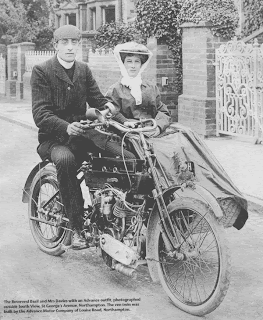Motorcycling vicars and me
It isn’t every day that a motorcycle is welcomed into a church … but that is exactly what happened on Sunday May 11 when I visited Bexhill on Sea for the unveiling of a Heritage Trail Blue Plaque.
It was a happy, ‘synchronous’ happening because I worship at a St Barnabas church (in Purley, Surrey) and the unveiling was at St Barnabas, Bexhill. But there was another, mor important, connection … to an illustrious ‘predecessor’ of mine: the multi-talented Canon Basil Davies, BA to whom the Blue Plaque was dedicated. (I take liberties using the term ‘predecessor’ – see later).
But, back to the point of this blog - allow me to explain. In 1975 I started work at my dream job as a reporter on Motor Cycle Weekly, a newspaper for motorcycle enthusiasts. It was a terrific opportunity to mix business and pleasure. And there was plenty of worldwide travel.
At the time I was only dimly aware that ‘Motor Cycle Weekly’ had an illustrious past, but gradually learned that my new paper had begun in 1903 at the dawn of motorcycling, in magazine form, as ‘The Motor Cycle’. A colleague had begun spending (too much) time in the archives and was boring me senseless with tales of a weekly column that went under the by-line of ‘Ixion’. (Ixion was a Greek character, condemned to be bound to a spinning, winged fiery wheel for eternity).
Ixion wrote about event-filled pioneering motorcycling escapades where an ability to fix these primitive machines by the side of the road in all weathers, was just as crucial as a knowledge of where to purchase supplies of ‘petroleum spirit’.
In spite of my colleague’s badgering, I started digging into Ixion’s archives and was soon hooked. The prose was fluent, colourful and very Edwardian. But who was Ixion? I soon discovered that this prolific contributor – he wrote for the Motor Cycle from 1901 to 1961 – was Canon Basil Davies, BA! A motorcycling priest! In 1901! And I thought that biking vicars were very modern in the seventies.
Here he was, variously kitted out with goggles, long flapping cloak, a cap (sometimes) and with oil under his fingernails. There’s one image I treasure of Canon Davies astride an ancient 'Advance' motorcycle and sidecar, dog collar very evident with his wife dressed in bonnet and ribbon for a Sunday ride out. It is magnificent – see for yourselves, below...
I won’t bore you with more detail of the motorcycling exploits of Canon Davies, except to say that he published several books on motorcycling and, if you can spare the time to visit a library and read his works, I am sure you will find yourselves enthralled … not just with his descriptions of pioneering motorcyclists, but also his beautiful, literate prose.
Here’s an example, below, reproduced from http://www.sidecar.com/Files/IXION.pdf and gathered together in a book - Reminiscenses of Motor cycling.
Skip it at your loss!
INTRODUCTION
THE other day I saw a revival of The Belle of New York
Our weird hobby seemed to be without excuse or justification: it veneered us with a permanent grime which, exceeded every known form of filth alike in squalor and in adhesiveness. The uncertainty of being able to start on a journey was only exceeded by the improbability of our ever reaching our destination in the saddle.
We were unquestionably doomed to spend long hours by the roadside, under conditions that ranged from grilling sun to a frosty night, from desperate solitude to a seething mob.
Such times of penance were usually devoted to the identification of some mystic ailment which afflicted our machines. The odds in the first place were heavily against our being able to trace the trouble; in the second place the betting was equally strong against our being able to remedy it, if found. There were no garages; the longest push could only bring us to the door of some ambitious cycle repairer, more ignorant and less cautious than ourselves.
When it rained, we side-slipped and got drenched, for our machines were woefully top-heavy, and the modern dreadnought clothing was not dreamt of. In winter we suffered from frostbite. In summer our engines
overheated. Our belts slipped and broke and pulled through without partiality under all conditions; the slip which they developed in wet weather was not more habitual than the glaze from which their leather suffered when roads were dry and dusty. Most of us were ex-cyclists; but such a hideous past was no palliation of our folly.
We could not claim that motorcycles were faster than pushbikes; we often covered a few miles at a speed which was then regarded as suicidal - say 24 miles an hour or so; but from beginning to end of a cross-country journey the prehistoric motorcycle was generally slower than a scissors-grinder’s handcart. We could not claim that we preferred the motorcycle for hillwork; for the main difference between it and the pushbike where gradients were concerned, was that the latter was very distinctly easier to push.
Economy could be no factor in our inexplicable conduct. A new machine might easily cost £75 to buy. Its repair bill was long enough to stagger a munition magnate, and it was out-of-date soon after it had been delivered. The most sympathetic student of human nature might be pardoned for comparing us to the gentleman who carried a slice of toast with him under the impression that he was a poached egg.
Now that the horse is all but extinct, I may inform the curious that it was an observant, suspicious and ignorant animal. When motorcycles first dawned on its vision, it took careful stock of them. Several disturbing points were immediately obvious. Motorcycles smelt abominably. The men who accompanied them on the roads were dreadful ruffians. Sometimes a motorcycle might be met travelling at inconceivable velocities. On other occasions, indeed more commonly, they were found stationary by the roadside. This latter attitude was pure cunning, intended to entice unwary horses up to close range before the noise and smell began. The new monster was evidently a lethal projectile, a kind of bomb on wheels; when it was in motion, you could hear the clockwork whirring in its inside, and you would be half deafened by its repeated efforts to detonate. We produced some such impression on the horses of our day. The consequence was that when they sighted us they immediately did an “about turn” and worked up to maximum revolutions in an amazingly few yards.
The staidest old Dobbin would instantly become oblivious to the presence of kind mistress and the family barouche behind him. Many nasty accidents occurred as a result, and timid horse owners became afraid to venture on the roads.
(If you delight in his prose, as I do, you will understand why I said I took liberties with my terminology when you read my efforts. If you do, of course!
So there I was at St Barnabas Church, Bexhill on Sunday amongst crowds of motorcyclists, and Basil Davies’ son Godfrey ‘Joff’, 99, the guest of honour. Amongst the crowds were at least 20 members of the Davies family, members of the Sunbeam MCC who campaigned for the Blue Plaque and who organised the unveiling.
Father Roger Crosthwaite, the vicar of St Barnabas, who had welcomed a vintage Sunbeam motorcycle into his church and dozens of others in the car park outside, spoke about his Edwardian predecessor and, naturally, wanted to say something about Canon Davies the Man of God. Fr Roger impressed on us that Canon Davies was a brilliant parish priest, who did not let his motorcycling or his journalistic freelancing get in the way of his ‘proper job’. He was popular and dedicated. And at the time of the Durham
How Canon Davies fitted it all in remains a mystery, especially as ‘Joff’ told us his father also published several books on cricket!
Chris Myers
PS: Motor Cycle Weekly reverted to magazine form in the 1980s as its new publishers, IPC, tried to turn a profit. That didn’t work and the last issue appeared in 1983. The valuable and extensive archive, and photographs, is now owned by the Mortons Media Group who, I hope, will allow me to reproduce this fine picture of Ixion.


Comments
Post a Comment